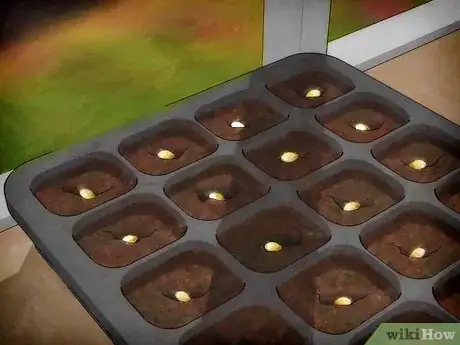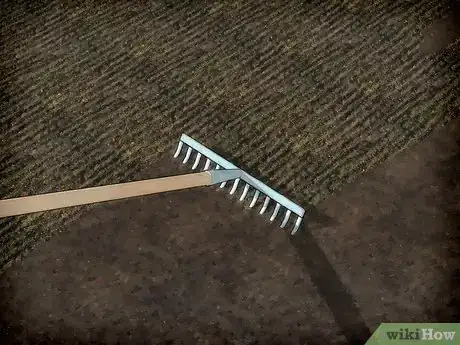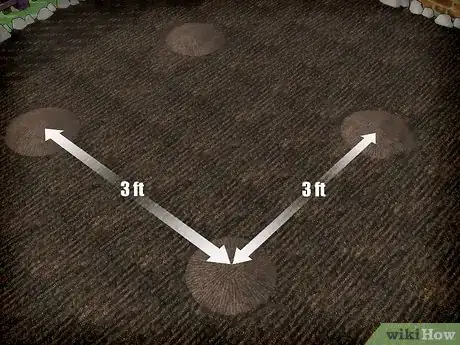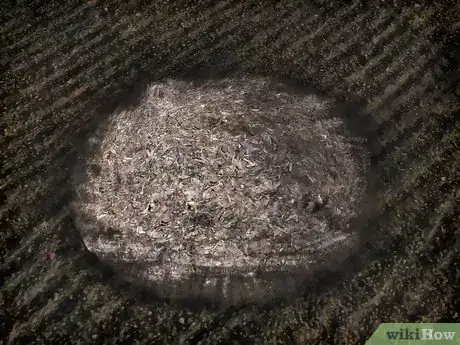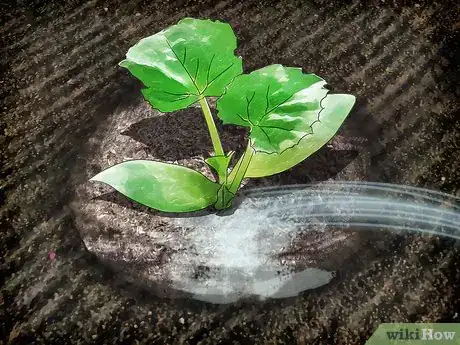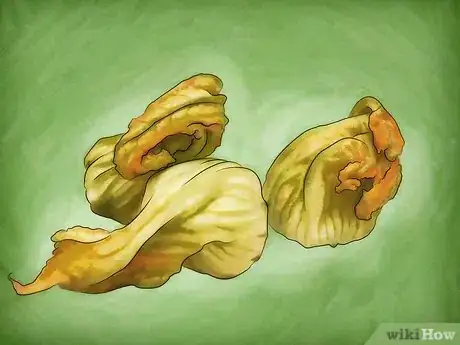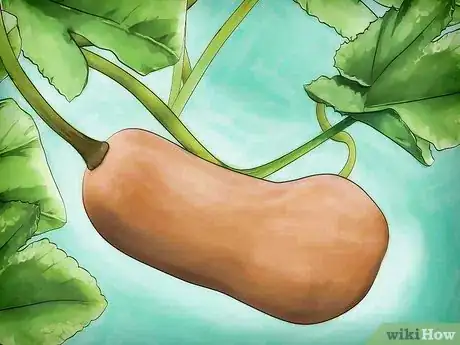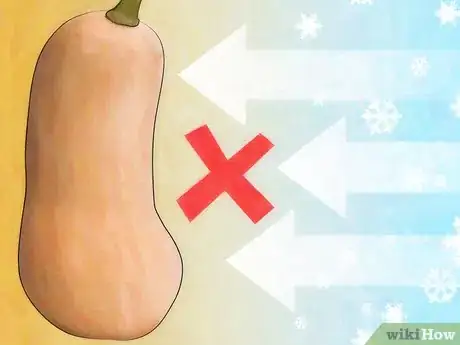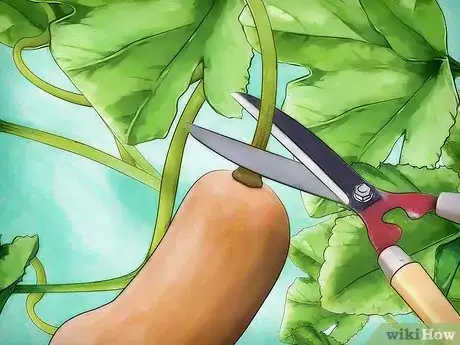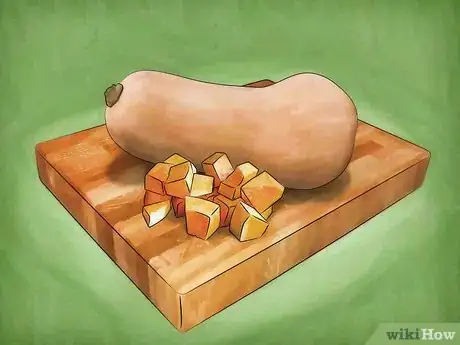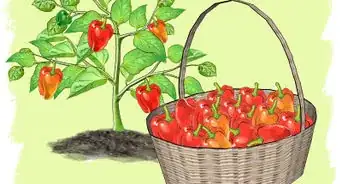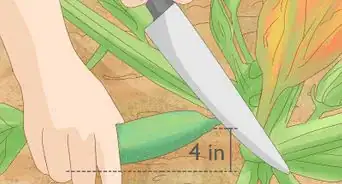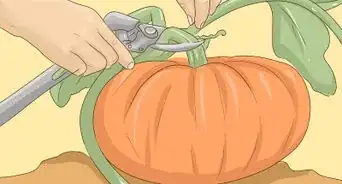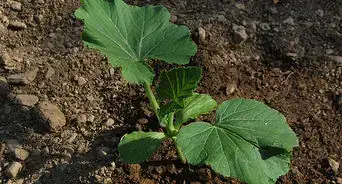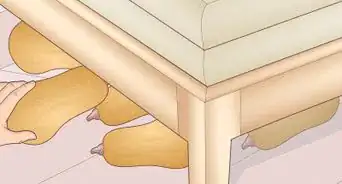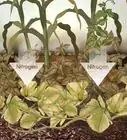This article was co-authored by Andrew Carberry, MPH. Andrew Carberry is a Food Systems Expert and the Senior Program Associate at the Wallace Centere at Winrock International in Little Rock, Arkansas. He has worked in food systems since 2008 and has experience working on farm-to-school projects, food safety programs, and working with local and state coalitions in Arkansas. He is a graduate of the College of William and Mary and holds a Masters degree in public health and nutrition from the University of Tennessee.
wikiHow marks an article as reader-approved once it receives enough positive feedback. This article received 14 testimonials and 91% of readers who voted found it helpful, earning it our reader-approved status.
This article has been viewed 185,352 times.
Butternut squash is a winter vegetable that is deliciously baked, stewed or made into a warm winter soup. This squash variety is planted during spring season and harvested in the fall once its outer skin has hardened. Read this article to learn how to grow and harvest butternut squash.
Steps
Planting Butternut Squash
-
1Plant once the soil has warmed. Butternut squash seeds won't germinate in cold soil, so it's necessary to plant them once you're certain the last frost has passed. In warmer climates this could be in mid-spring, and in cooler climates you might have to wait until late spring. If you plant your squash too early, it won't survive.
- If you want to get a head start, you can start the seeds indoors up to 3 weeks before the last frost. Plant the seeds 1 inch (2.5 cm) deep in seed starter mix in small pots. Keep them moist and warm until the last frost has passed, after which you can transplant them to the garden.
-
2Choose a warm, sunny spot to plant the squash. Butternut squash needs full sun and warm conditions to thrive. It will do well in the sunniest spot in your garden. Avoid planting it in the shade, since the squash won't fully ripen without full sunlight.Advertisement
-
3Enrich the soil if necessary. Butternut squash needs rich, well-draining soil. If your soil is poor, till it to a depth of several inches and mix in plenty of compost. Depending on how many squash plants you're putting in, you may need to prepare a large area to serve as your planting bed. Plan to allot 3 square feet of space per squash plant.
-
4Plant the seeds in small hills. Squash grow best when they are planted in soil that has been hilled. Create hills about 3 inches (7.6 cm) high for each squash plant, leaving at least 3 feet (0.9 m) of space between hills in the same row, and 6 feet (1.8 m) between rows. Dig a hole 1 inch (2.5 cm) deep in the top of each hill and drop in 4-5 squash seeds. Cover the seeds with soil and pat the area lightly.
- After the seeds sprout, thin them out to leave 2 - 3 sprouts per hill.
- If you're transplanting squash plants that you started indoors, plant each one on its own hill.
- Squash vines can either grow along the ground or on a trellis. If you wish to train your squash plants to grow vertically, place a trellis or stake near each hill. When the vines sprout, wrap them gently around the base of the trellis or stake, and they'll begin growing upward.
-
5Lightly mulch the squash beds. Spread some pine straw or another light mulch over the squash beds to protect the growing plants.
Caring for Butternut Squash
-
1Water the squash plants regularly. Keep the soil moist throughout the summer by watering the squash every few days. When the soil looks like it's getting a little dry, give the squash beds a thorough soaking. Water at the base of the plants, rather than getting the leaves wet, to prevent powdery mildew and sunburn.
-
2Eat the early squash blossoms. The first blossoms the squash plants produce are male, and eating them won't affect the health of the plants. If you'd like, pinch off the yellow blossoms and add them to salads or stir-fries. Otherwise, they'll naturally fall off about a week after they bloom.
- The second set of flowers produced by the plants are female, and they grow just above the tiny squash fruits. Leave the female flowers on the vines.[1]
-
3Keep pests away. Squash plants don't usually become attractive to pests until the end of the growing season when the plants have almost reached the end of their life cycle anyway. If you know pests are a problem in your area, take measures to prevent an infestation:
- Protect young squash plants by covering them with floating row cover. Remove the cover once they begin to flower to allow pollination.
- Planting a row of nasturtium flowers alongside your squash can help deter insect pests.
- If you see squash bugs or cucumber beetles on the leaves of the squash plants, pick them off by hand.
- Squash vine borers attack the plants inside the stalks. Unfortunately, once they attack, there's not much you can do to save the plants.[2]
Harvesting Butternut Squash
-
1Wait until the squash are fully ripe. When you can press your fingernail into a squash without denting its surface, that means the squash are ripe. It's important to wait until the surface is tough - otherwise, the squash will go bad quickly.
-
2Harvest before the first frost of the season. If you wait too long to harvest the squash, and they get exposed to a frost, they will rot more quickly than they would have if you harvested them before the temperature dropped. Plan to harvest them before the weather turns.
-
3Cut the squash from the vines. Use a sharp knife to cut them from the vines, leaving a few inches of stem intact. Take them inside right away and rinse the dirt from their surfaces. There's no need to leave them outside to cure.
-
4Store the squash. Fully mature butternut squash will keep for months in storage. Store your squash in a cool, dry place and enjoy it all winter long. When you're ready to enjoy your squash, read the following articles to find out more:
- How to Cut Butternut Squash
- How to Make Butternut Squash Soup
- How to Roast Butternut Squash
Expert Q&A
Did you know you can get expert answers for this article?
Unlock expert answers by supporting wikiHow
-
QuestionCan I cut the vine to stop it from growing out?
 Andrew Carberry, MPHAndrew Carberry is a Food Systems Expert and the Senior Program Associate at the Wallace Centere at Winrock International in Little Rock, Arkansas. He has worked in food systems since 2008 and has experience working on farm-to-school projects, food safety programs, and working with local and state coalitions in Arkansas. He is a graduate of the College of William and Mary and holds a Masters degree in public health and nutrition from the University of Tennessee.
Andrew Carberry, MPHAndrew Carberry is a Food Systems Expert and the Senior Program Associate at the Wallace Centere at Winrock International in Little Rock, Arkansas. He has worked in food systems since 2008 and has experience working on farm-to-school projects, food safety programs, and working with local and state coalitions in Arkansas. He is a graduate of the College of William and Mary and holds a Masters degree in public health and nutrition from the University of Tennessee.
Food Systems Expert
-
QuestionHow do you tell when butternut squash is ready to harvest?
 Andrew Carberry, MPHAndrew Carberry is a Food Systems Expert and the Senior Program Associate at the Wallace Centere at Winrock International in Little Rock, Arkansas. He has worked in food systems since 2008 and has experience working on farm-to-school projects, food safety programs, and working with local and state coalitions in Arkansas. He is a graduate of the College of William and Mary and holds a Masters degree in public health and nutrition from the University of Tennessee.
Andrew Carberry, MPHAndrew Carberry is a Food Systems Expert and the Senior Program Associate at the Wallace Centere at Winrock International in Little Rock, Arkansas. He has worked in food systems since 2008 and has experience working on farm-to-school projects, food safety programs, and working with local and state coalitions in Arkansas. He is a graduate of the College of William and Mary and holds a Masters degree in public health and nutrition from the University of Tennessee.
Food Systems Expert
-
QuestionThis year I got many flowers but no fruit. What should I do?
 Community AnswerAvoid much use of fertilizers enriched high amounts of phosphorus. Instead, use fertilizers enriched with potassium, which will increase the rate of fruition.
Community AnswerAvoid much use of fertilizers enriched high amounts of phosphorus. Instead, use fertilizers enriched with potassium, which will increase the rate of fruition.
Things You'll Need
- Butternut squash seeds
- Water
- Compost
- Hoe
- Insecticide
- Mulch
- Shovel or spade
References
About This Article
To grow butternut squash, choose a sunny part of your garden to plant your seeds in after the last frost has passed. Till the soil a few inches deep and mix in some compost, then plant your seeds in small hills of soil, leaving roughly 3 feet of space around each plant. To ensure the soil stays moist, water the squash every few days during the summer. If you're unsure when to harvest the squash, wait until you can press your finger onto its surface without denting it as this shows the squash is fully ripe. For tips on keeping pests like cucumber beetles away from your squash, keep reading!
